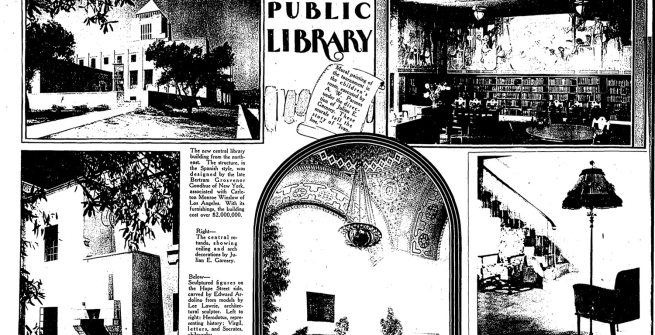In July of 1926, Angelenos eagerly awaited the opening of the Los Angeles Central Library's new building, the first permanent home for the fifty-year-old library. In 1923 and 1924, the Los Angeles Times covered the library's planning and construction, and in 1926 published a series of articles about the new library, detailing the award of the contract to Julian Garnsey for the painted ceilings, the move from the library's old home in the Metropolitan Building, and the much anticipated opening.
The library opened to the public on July 6, and was dedicated on July 15. The dedication ceremony dominated the front pages of both the Evening Herald and the Los Angeles Times.
The dedication was held in the Rotunda, and included an invocation by Bishop Johnson of the Episcopalian Church, a presentation of the building by architect Carter Winslow, addresses by City Librarian Everett Perry, Mayor Cryer, and Rabbi Ernest Trattner, and a closing invocation by Bishop Cantwell of the Catholic Church. The general public was invited to a reception following the ceremony. Hundreds attended.

Los Angeles Times, August 1, 1926. Copyright 1926. Los Angeles Times. Reprinted with permission
Before the Goodhue Building, the library (founded in 1872) had four different homes. Tracing their locations gives us a map of downtown over time. The library started at the Downey Block at Spring and Temple (the site that now houses the Federal Courthouse), then moved to Old City Hall on Broadway, then to the Homer Laughlin Building, on the part of Hill Street where we now find the Grand Central Market (home to award-winning restaurants) which featured a roof garden reading room.

Roof garden reading room at the Homer Laughlin Building, taken between 1906-1908. The Los Angeles Public Library Photo Collection
Next the library moved to the grand Beaux Arts Hamburger Department Store (featuring, in the non-library parts of the building, a restaurant, an 80-foot soda fountain, a post office, and a doctor's office), and finally to four floors of the Metropolitan Building, on Fifth between Broadway and Hill. Library patrons told the LA Times that compared to the earlier locations, the Metropolitan Building looked something like "a real library," but crowds cheered when vans pulled up outside the Metropolitan Building to start the move to the new Central Library—a "real library" indeed.
The early locations are long gone, but the Metropolitan Building—now, loft housing—still stands, as does the Hamburger Building, which in 1927 was re-named the May Company Building, and is now slated for renovation.

The Fiction Department in the Metropolitan Building. The Los Angeles Public Library Photo Collection
How did we go from a few rented floors to a wonderful Central Library building? Between the 1870s and the 1920s, Los Angeles changed so much and so quickly that people tend to use words like "exploded!" and "boom!" to describe the growth. Population, which was about 100,000 at the turn of the century, and slightly under 600,000 by 1920, was more than 1.2 million in 1929. As population doubled, library use skyrocketed. There were 85,000 library cardholders in 1914, and 215,000 in June of 1925.
In 1919, Los Angeles was a minor player in industry. By 1930, we were first in the nation in movie production, second in automobile manufacturing. We had an important petroleum industry after new oil fields were discovered in Huntington Beach, Long Beach, and Santa Fe. Writer Carey McWilliams wrote that "the history of Los Angeles is the history of its booms," and that the boom of the 20s was "a truly bonanza affair."
By this time, other major US cities had important buildings to house their central library, and Los Angeles wanted one too. After much political argument, the current site was selected, and in June of 1921, 71 percent of voters voted 'Yes' on a bond issue to fund construction. (For more on the fascinating history of those years, read our blog post Horsetrading and Angry Feminists: Central's Backstory.
Architect Bertram Goodhue was hired, and in 1924, construction began.

Excavation for the Goodhue Building. January 26, 1924, the Los Angeles Public Library Photo Collection
By December, the site looked like this:

The Goodhue Building under construction. December 31, 1924. The Los Angeles Public Library Photo Collection
Less than a year later, our library had taken shape.

The Goodhue Building under construction, November 2, 1925. The Los Angeles Public Library Photo Collection
By late June of 1926 the move from the Metropolitan Building was underway. The Los Angeles Times reported that 360,000 books, 4000 catalog drawers, and tons of records and documents were moved to the new library.

The Los Angeles Times, June 27, 1926.Copyright 1926. Los Angeles Times. Reprinted with permission
Even after the July 1926 opening, Library construction continued. The Flower Street entrance didn't open until early November, when the LA Times reported that the Fifth Street, Grand Avenue, and Hope Street entrances still awaited the "touch of the carver." Perhaps the final flourish took place in 1933, when the Dean Cornwell California History Murals were mounted in the Rotunda.
—Written by Kate Kaplan, Central Library Docent
Please join us for a docent-led tour of the Central Library.
